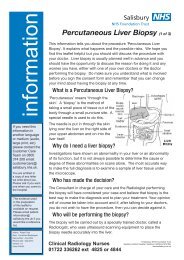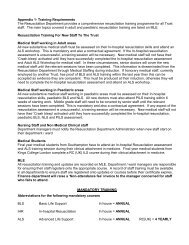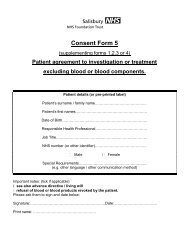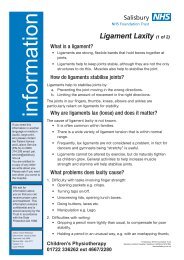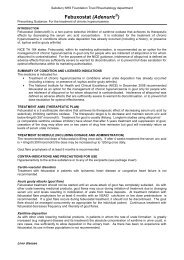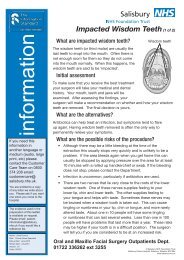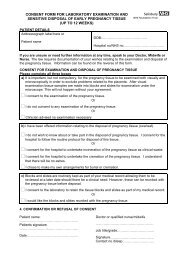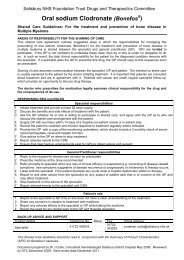The Brandt-Daroff Exercise (1 of 2) - ICID - Salisbury NHS ...
The Brandt-Daroff Exercise (1 of 2) - ICID - Salisbury NHS ...
The Brandt-Daroff Exercise (1 of 2) - ICID - Salisbury NHS ...
Create successful ePaper yourself
Turn your PDF publications into a flip-book with our unique Google optimized e-Paper software.
information<br />
<strong>The</strong> <strong>Brandt</strong>-<strong>Dar<strong>of</strong>f</strong> <strong>Exercise</strong> (1 <strong>of</strong> 2)<br />
If you need this<br />
information in another<br />
language or medium<br />
(audio, large print, etc)<br />
please contact the Patient<br />
Advice and Liaison<br />
Service (PALS) on<br />
0800 374 208 email:<br />
palservice@salisbury.<br />
nhs.uk<br />
You are entitled to<br />
a copy <strong>of</strong> any letter<br />
we write about you.<br />
Please ask if you want<br />
one when you come to<br />
the hospital<br />
We ask for information<br />
about you so<br />
that you can receive<br />
proper care and treatment.<br />
This information<br />
remains confidential<br />
and is stored<br />
securely by the Trust<br />
in accordance with<br />
the Data Protection<br />
Act 1998.<br />
Author: B Claesen<br />
Date written: October 2008<br />
Approved: November 2008<br />
Review date: November 2011<br />
Version: 1.0<br />
Code: PI0126<br />
<strong>The</strong> <strong>Brandt</strong>-<strong>Dar<strong>of</strong>f</strong> exercise is a method <strong>of</strong> treating benign paroxysmal<br />
positional vertigo (BPPV).<br />
What is benign paroxysmal positional vertigo (BPPV)?<br />
BPPV is a condition <strong>of</strong> the inner ear. It is a common cause <strong>of</strong> vertigo,<br />
especially in older people.<br />
• Benign means that it is not due to cancer or other serious cause.<br />
(<strong>The</strong> symptoms <strong>of</strong> BPPV may be unpleasant but the underlying<br />
cause is not serious.)<br />
• Paroxysmal means ‘recurring sudden episodes <strong>of</strong> symptoms’.<br />
• Positional means that the symptoms are triggered by certain<br />
positions. In BPPV it is certain positions <strong>of</strong> the head that trigger<br />
symptoms.<br />
• Vertigo is dizziness with a spinning sensation. If you have vertigo<br />
you feel as if the world is spinning around you and you feel very<br />
unsteady. Often you will also feel sick and may vomit.<br />
BPPV causes short episodes <strong>of</strong> vertigo (intense dizziness) when you<br />
move your head in certain directions. It is thought to be caused by<br />
tiny fragments <strong>of</strong> debris in the inner ear labyrinth. In many cases the<br />
condition clears away on its own after several weeks.<br />
What can be done to help BPPV?<br />
A simple treatment <strong>of</strong> moving the head into various positions over a few<br />
minutes can usually cure the condition. This treatment uses gravity to<br />
move the debris away from where it is causing problems.<br />
<strong>The</strong> exercise must be done in both directions, even if an audiologist or<br />
ENT specialist has told you that your problem occurs on one side only.<br />
You are likely to feel a sensation <strong>of</strong> vertigo, especially so on the problem<br />
side. This is quite normal and will pass within a few seconds. <strong>The</strong> more<br />
you do the movements, the feeling <strong>of</strong> vertigo will lessen.<br />
Please see overleaf for a diagram that shows how to do the exercise.<br />
1. <strong>The</strong> exercise is best done sitting on a bed so you have support<br />
(position 1). You should start with the side that provokes vertigo<br />
or dizziness.<br />
2.<br />
Whilst sitting up, tilt your head to a 45 degree angle away from<br />
the side that causes vertigo. Move quickly from a sitting position<br />
Audiology Department<br />
01722 429335<br />
© <strong>Salisbury</strong> <strong>NHS</strong> Foundation Trust<br />
<strong>Salisbury</strong> District Hospital, <strong>Salisbury</strong>, Wiltshire SP2 8BJ<br />
www.salisbury.nhs.uk
<strong>The</strong> <strong>Brandt</strong>-<strong>Dar<strong>of</strong>f</strong> <strong>Exercise</strong> (2 <strong>of</strong> 2)<br />
to lying down on the side that causes vertigo. Stay in this position for at least 30<br />
seconds (position 2).<br />
3.<br />
4.<br />
<strong>The</strong>n sit up quickly and stay there for 30 seconds keeping your head in the same<br />
position as when you were lying down (position 3).<br />
<strong>The</strong>n turn your head to the opposite direction (in the direction that causes the vertigo)<br />
and you then quickly lie down on your side (on the opposite side that causes the<br />
vertigo). Hold this position for 30 seconds, then sit up quickly and stay there for 30<br />
seconds (position 4).<br />
How <strong>of</strong>ten should I do this exercise?<br />
You need to repeat these movements, one after the other, about 10-20 times, three times a<br />
day, until the vertigo is absent for two days in a row.<br />
Where can I get more information?<br />
Please contact the Audiology Department if you have any problems.<br />
Audiology Department<br />
01722 429335<br />
© <strong>Salisbury</strong> <strong>NHS</strong> Foundation Trust<br />
<strong>Salisbury</strong> District Hospital, <strong>Salisbury</strong>, Wiltshire SP2 8BJ<br />
www.salisbury.nhs.uk



